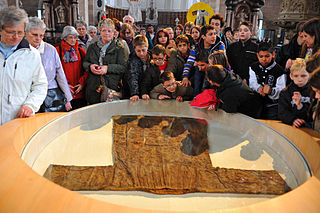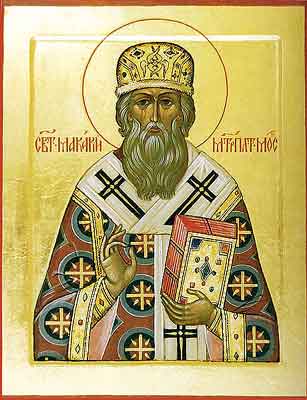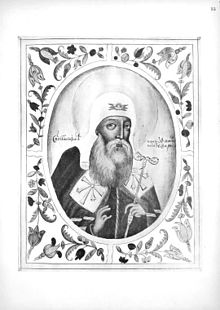
Tikhon of Moscow, born Vasily Ivanovich Bellavin, was a bishop of the Russian Orthodox Church (ROC). On 5 November 1917 (OS) he was selected the 11th Patriarch of Moscow and All Russia, after a period of about 200 years of the Synodal rule in the ROC. He was canonised as a confessor by the ROC in 1989.

The Moscow Kremlin or simply the Kremlin is a fortified complex in Moscow, Russia. Located in the centre of the country's capital city, it is the best known of the kremlins and includes five palaces, four cathedrals, and the enclosing Kremlin Wall along with the Kremlin towers. Within the complex is the Grand Kremlin Palace, which served as the royal residence of the Emperor of Russia. It is now the official residence of the President of the Russian Federation. The Kremlin overlooks the Moskva River to the south, Saint Basil's Cathedral and Red Square to the east, and Alexander Garden to the west.

The Cathedral of the Dormition, also known as the Assumption Cathedral or Cathedral of the Assumption, is a Russian Orthodox church dedicated to the Dormition of the Theotokos. It is located on the north side of Cathedral Square of the Moscow Kremlin in Russia, where a narrow alley separates the north from the Patriarch's Palace with the Twelve Apostles Church. Separately in the southwest, also separated by a narrow passage from the church, stands the Palace of Facets. The cathedral is regarded as the mother church of Muscovite Russia.

The Seamless Robe of Jesus is the robe said to have been worn by Jesus during or shortly before his crucifixion. Competing traditions claim that the robe has been preserved to the present day. One tradition places it in the Cathedral of Trier, another places it in Argenteuil's Basilique Saint-Denys, and several traditions claim that it is now in various Eastern Orthodox churches, notably Svetitskhoveli Cathedral in Mtskheta, Georgia.

The Chudov Monastery was founded in the Moscow Kremlin in 1358 by Metropolitan Alexius of Moscow. The monastery was dedicated to the miracle of the Archangel Michael at Chonae. The Monastery was closed in 1918 and dismantled in 1929 by the Soviet government.

Job, also known as Job of Moscow, was the first Patriarch of Moscow and All Russia. He is venerated as a saint by the Russian Orthodox Church. He was the Metropolitan of Moscow and all Rus' from 1587 to 1589. He was the seventeenth Metropolitan in Moscow to be appointed without the approval of the Ecumenical Patriarch of Constantinople as had been the norm. In 1589, Jeremias II, the Patriarch of Constantinople, regularized Job's canonical status and raised him to the status of patriarch.

Feodor Nikitich Romanov was a Russian boyar who after temporary disgrace rose to become patriarch of Moscow as Filaret, and became de facto ruler of Russia during the reign of his son, Mikhail Feodorovich.

Hermogenes, or Germogen was the Patriarch of Moscow and all Russia from 1606. It was he who inspired the popular uprising that put an end to the Time of Troubles. Hermogenes was glorified by the Russian Orthodox Church in 1913.

Alphabetical list of Eastern Christianity-related articles on English Wikipedia

August 14 - Eastern Orthodox liturgical calendar - August 16

Macarius was the Metropolitan of Moscow and all Rus' from 1542 until 1563. He was the tenth metropolitan in Moscow to be appointed without the approval of the Ecumenical Patriarch of Constantinople as had been the norm.

Jonah of Moscow was Metropolitan of Kiev and all Rus' from 1448 until his death in 1461.

The Estonian Orthodox Church of the Moscow Patriarchate is a semi-autonomous church in the canonical jurisdiction of the Patriarchate of Moscow whose primate is appointed by the Holy Synod of the latter.

The Diocese of Novgorod is one of the oldest offices in the Russian Orthodox Church. The medieval archbishops of Novgorod were among the most important figures in medieval Russian history and culture and their successors have continued to play significant roles in Russian history up to the present day. They patronized a significant number of churches in and around the city,, and their artistic and architectural embellishments influenced later Russian art and architecture; they also patronized chronicle-writing, a crucial source on medieval Russian history.

The Church Reform of Peter the Great was a set of changes Tsar Peter I introduced to the Russian Orthodox Church, especially to church government. Issued in the context of Peter's overall westernizing reform programme, it replaced the Patriarch of Moscow with the Holy Synod and made the church effectively a department of state.
Joasaph is a masculine given name. Joasaph is another name for Josaphat, the legendary martyred prince in the story of Barlaam and Josaphat; according to E. A. Wallis Budge, this name Joasaph ultimately originated as a mistranslation of Bodhisattva. The Ethiopic form of the name is Yewasef. People with this name include:
The 1000th Anniversary of the Christianization of Rus' was an occasion marked by events held in the USSR from May – June 1988, to celebrate the introduction of Christianity to Russia by Prince Vladimir Svyatoslavich in 988. Originally, the celebrations were planned for the church only. However, the anniversary became a statewide event. That this was allowed to occur marked a shift in Soviet policy concerning the church.

Metropolitan Tikhon is a bishop of the Russian Orthodox Church and a popular writer. He is the Metropolitan of Pskov and Porkhov; in October 2023 it was reported that he was to be moved to the Diocese of Simferopol and Crimea.

Athanasius III Patellarios was the Patriarch of Constantinople in 1634, 1635 and 1652. Before his patriarchate Athanasius was metropolitan of Thessaloniki. He participated at Patriarch Nikon's book editing reforms in 1653.
















